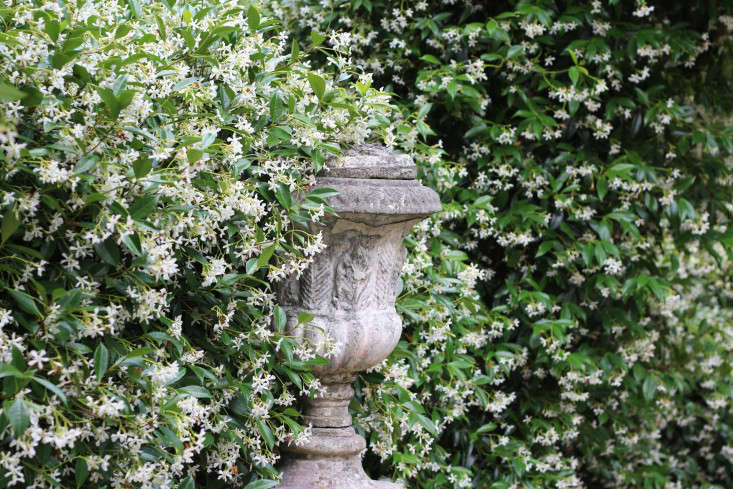Jasmine, Jasmine officinale: “Queen of the Night”
Among gardeners it is widely known that puttering among plants is a reliable antidote to stress and sadness. And herbalists have long claimed the same benefits for aromatherapy. But, until very recently, science has not backed up these claims. Now laboratory studies have proved that, at least for mice, inhaling the perfume of jasmine is just as calming to the nervous system as taking Valium. Apparently, breathing in the molecules of oil extracted from the delicate star-shaped jasmine flower transmits an energizing message of wellbeing to the brain.
So, if you needed another reason to grow this sweet smelling tropical, which gets its name from the Arabic “yasmin” meaning, appropriately, “fragrant flower,” modern science has given you one.
Above: Photograph by Olivia Rae James. For more see Charleston: A Walk in the Neighborhood.
People through the ages have cultivated this plant which is a native of Asia and probably originated in Iran before crossing the Red Sea into Egypt around 1000 B.C. It has been promoted by Chinese emperors and kings of Afghanistan, Nepal, and Persia who ordered it planted around their palaces in the 1400s.
Above: Photograph by Toshiyuki Imai via Flickr.
A vigorous woody climber that can top out at 40 feet, Jasmine belongs to the genus Jasminum which has about 200 species and is related to olive trees.
Above: Photograph by Marie Viljoen. Confederate jasmine frames an old urn among the flowers. For more of this garden, see Under the Radar: A Five-Star Garden in Cape Town.
Cheat Sheet
- Jasmine officinale, also known as common or poet’s jasmine, is an aggressive twining shrub that needs frequent pruning to keep it under control and trained to a trellis or fence.
- Evergreen in zones 7 to 10, this plant can be used as a fragrant hedge in warmer climates and will perfume an entryway or patio as a container plant.
- For the most abundant blooms, this plant needs cold night temperatures in winter to stimulate flower production and is not a good candidate for wintering over in a sunny window or a warm greenhouse.
Keep It Alive
- Jasmine officinale is also known as hardy jasmine because it can be grown in cold climates as a deciduous perennial that should be sited in a protected area and heavily mulched to get it through freezing weather (down to zero in short periods).
- Jasmine officinale blooms from late spring until frost on new growth, which means spring pruning will not interfere with the formation of the prized small flowers.
- This plant likes well drained moderately fertile soil, plenty of water during the active growing season and, although it is tolerant of shade, prefers a sunny location.
Above: Photograph by T. Kiya via Flickr.
Aside from its role of permeating our gardens, jasmine is a presence also in our culture by showing up as a common name for girls, a feisty Disney movie character, and as an ingredient in teas and expensive perfumes. Jasmine tea is used worldwide as the ubiquitous beverage served in Chinese restaurants. While it is often made by adding jasmine oil (or a chemical simulation) to low-grade tea, the best jasmine tea is made by infusing high-quality white or green teas with freshly picked jasmine flowers.
Above: Trailing white jasmine anchors an arrangement in DIY: Reclaiming an Old-Fashioned Cut-Glass Vase. Photograph by Erin Boyle.
Luxurious perfumes such as Joy, Shalimar, Diorissimo, and Chanel No. 5 all depend on the heady scent of jasmine grown commercially in France, Spain, Japan, Morocco, and Turkey. Since jasmine is a night bloomer, workers must harvest the flowers after the sun goes down. Experienced pickers can bring in 10,000 blossoms in one night. That figure is impressive until you realize that around 7.5 million flowers are required to produce approximately two pounds of essential oil… a fact that might help assuage the guilt when you next hand over your credit card for a pricey bottle of perfume.
Do you want to cover fence with a vine or climber? See more of our Gardening 101 favorites, including Wild Grape Vine, Creeping Fig, and Wisteria.
For more growing and design tips, see our curated guide to Jasmine: A Field Guide to Planting, Care & Design.
Finally, get more ideas on how to successfully plant, grow, and care for jasmine with our Jasmine: A Field Guide.
Finally, get more ideas on how to plant, grow, and care for various vines and climbers with our Vines & Climbers: A Field Guide.













Have a Question or Comment About This Post?
Join the conversation